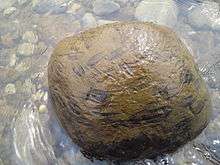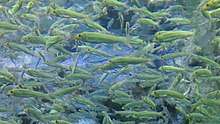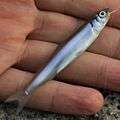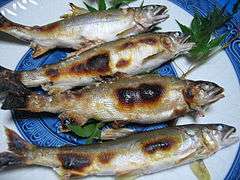Ayu
Ayu (アユ, 鮎, 年魚, 香魚) or sweetfish, Plecoglossus altivelis, is a species of fish. It is the only species in the genus Plecoglossus and family Plecoglossidae. It is a relative of the smelts and other fish in the order Osmeriformes.
| Ayu | |
|---|---|
 | |
| Scientific classification | |
| Kingdom: | |
| Phylum: | |
| Class: | |
| Order: | |
| Suborder: | Osmeroidei |
| Family: | Plecoglossidae |
| Genus: | Plecoglossus |
| Species: | P. altivelis |
| Binomial name | |
| Plecoglossus altivelis | |
Native to East Asia, it is distributed in the northwestern Pacific Ocean along the coast of Hokkaidō in Japan southward to the Korean Peninsula, China, Hong Kong and northern Vietnam. It is amphidromous, moving between coastal marine waters and freshwater lakes and rivers. A few landlocked populations also exist in lakes in Japan such as Biwa. It is an introduced species in Taiwan.[1]
The name "sweetfish" was inspired by the sweetness of its flesh. In reference to its typical one-year lifespan, it is also written as 年魚 ("year-fish").[2] Some individuals live two to three years.[1] The ayu is the prefectural fish of Gunma Prefecture and Gifu Prefecture.[3]
Subspecies
Two[4] to three[5] subspecies are recognized by some authors. Others do not distinguish the subtaxa.[6]
Subspecies include:
- P. a. altivelis (Temminck & Schlegel, 1846) (ayu, sweetfish)
- P. a. chinensis Y. F. Wu & X. J. Shan, 2005 (Chinese ayu)
- P. a. ryukyuensis M. Nishida, 1988 (Ryukyu ayu-fish) – endangered[7]
Biology


An omnivore, the ayu feeds on algae, crustaceans, insects, sponges, and worms. It feeds on algae that accumulates on the rocks, scraping it off the rocks with their saw-shaped teeth.[2][8] Adults typically maintain a feeding territory,[9] but the form restricted to lakes and associated streams is schooling.[10]
Most populations of this species are amphidromous and breed in the lower part of rivers during the autumn, laying their eggs in small pits they dig in the gravel.[1][11] The eggs hatch shortly after and the larvae are carried downriver to the sea.[12] They overwinter in coastal regions, staying there until the spring where the young fish typically are about 6 cm (2.5 in) long and move back to the rivers. Here they reach 15–30 cm (6–12 in) by the summer.[12] They reach maturity by the autumn and move down to the lower part of rivers to breed.[11] Some die after breeding and only live one year, but others return to live in the ocean and may spawn up to three times, each time moving into the lower part of rivers in the autumn.[1][13] In Japan, some populations live their entire life in freshwater, only moving between lakes and the associated streams where they breed. These have a more variable migration pattern, moving upstream from the lakes in the spring, summer or autumn.[11] Although their larvae mostly stay within freshwater, some are carried downstream with the current to the sea and become part of the amphidromous populations.[11] The freshwater-restricted populations typically reach an age of two or three years.[1][6] During the breeding season the amphidromous and freshwater-restricted forms may occur together.[12] Ayu are also stocked in reservoirs.[1]
Although there are reports of ayu up to 70 cm (2.3 ft) long,[6] a more typical maximum size for the species is about 30 cm (1 ft).[9][14] The form restricted to freshwater is considerably smaller than the amphidromous form.[10] The freshwater-restricted ayu of Lake Biwa that migrate into their spawning streams in the spring can reach up to about 15 cm (6 in) in length, but those that migrate later in the year, primarily in the autumn, only grow to 10 cm (4 in).[11][15] This is caused by differences in the availability of food.[15]
Human uses
Ayu is an edible fish, mostly consumed in East Asia. Its flesh has a distinctive, sweet flavour with "melon and cucumber aromas".[16] It is consequently highly prized as a food fish. The main methods for obtaining ayu are by means of fly fishing, by using a fish trap, and by fishing with a decoy which is known as ayu-no-tomozuri in Japan. The decoy is a living ayu placed on a hook, which swims when immersed into water. It provokes the territorial behavior of other ayu, which assault the "intruder" and get caught.[17]
Japanese fishers also catch it using cormorant fishing. On the Nagara River where Japanese cormorants (Phalacrocorax capillatus) are used by the fishermen, the fishing season draws visitors from all over the world. The Japanese cormorants, known in Japanese as umi-u (ウミウ, "sea-cormorant"), are domesticated birds trained for this purpose. The bird catches the ayu, stores it in its crop, and delivers it to the fishermen.[18]
Ayu is also fished commercially, and captive juveniles are raised in aquaculture before being released into rivers for sport fishing.
A common method of preparing ayu and other small fish in Japan is to skewer it in such a way so that its body forms a wave, making it look as though it is swimming.[19]
Gallery
 Young P. a. altivelis
Young P. a. altivelis Ayu no shio yaki
Ayu no shio yaki
(Ayu grilled with salt)- Ayu being grilled with salt in Japan; note the wave-like "swimming" shape of the skewered fish
 In watercolor
In watercolor
References
- Huckstorf, V. 2012. Plecoglossus altivelis. The IUCN Red List of Threatened Species. Downloaded on 18 February 2016.
- Queen of Freshwater Streams. Archived 25 April 2014 at the Wayback Machine Food Forum. Kikkoman Global Website.
- Symbols of Gifu Prefecture. Gifu Prefectural Government.
- Froese, R. and D. Pauly, Editors. Plecoglossus. FishBase. 2015.
- Shan, X., Wu, Y., & Kang, B. (2005). Morphological comparison between Chinese Ayu and Japanese Ayu and establishment of Wu & Shan subsp. nov. Journal of Ocean University of China (English Edition), 1(4), 61-66.
- Froese, R. and D. Pauly, Editors. Plecoglossus altivelis altivelis. FishBase. 2015.
- World Conservation Monitoring Centre 1996. Plecoglossus altivelis ryukyuensis. The IUCN Red List of Threatened Species. Downloaded on 5 November February 2016.
- "Rock Fishing in Tokushima, Japan". USA Today.
- Hooper, R. (21 September 2005). Ayu sweetfish. The Japan Times. Retrieved 13 February 2017.
- Shirakihara, Yoshids, Nishino, Takao and Sawada (2001). Acoustic evaluation of the vertical distribution of dwarf ayu Plecoglossus altivelis altivelis in Lake Biwa. Fisheries Science 67: 430–435.
- Lucas, M., and E. Baras (2001). Migration of Freshwater Fishes, p. 187. Blackwell Science. ISBN 0-632-05754-8
- Otake and Uchida (1998). Application of Otolith Microchemistry for Distinguishing between Amphidromous and Non-amphidromous Stocked Ayu, Plecoglossus altivelis. Fisheries Science 64(4): 517-521.
- Shimizu, Uchida, Udagawa, Inoue, Sato and Katsura (2007). Multiple spawning and related variations in female reproductive parameters of amphidromous type ayu. Fisheries Science 73(1): 9–18.
- FAO Fisheries and Aquaculture Department: Plecoglossus altivelis (Temminck & Schlegel, 1846). Retrieved 13 February 2017.
- Lake Biwa Museum: Aquarium. Retrieved 10 May 2019.
- Gadsby, P. The chemistry of fish. Discover Magazine 25 November 2004.
- Waldman, J. (2005). 100 Weird Ways to Catch Fish (1st ed.). Mechanicsburg, PA: Stackpole Books. pp. 6–7. ISBN 0811731790.
- Cormorant-Fishing on the Nagara River. Gifu Rotary Club.
- No. 2: Ayu fish. Hiroko's Kitchen. 10 August 2010.
Further reading
- Takeshima, Hirohiko; Iguchi, Kei-ichiro & Nishida, Mutsumi (2005): Unexpected Ceiling of Genetic Differentiation in the Control Region of the Mitochondrial DNA between Different Subspecies of the Ayu Plecoglossus altivelis. Zool. Sci. 22(4): 401–410. doi:10.2108/zsj.22.401 (HTML abstract)
External links
| Wikimedia Commons has media related to Ayu. |
- Plecoglossus altivelis. Integrated Taxonomic Information System (ITIS).
